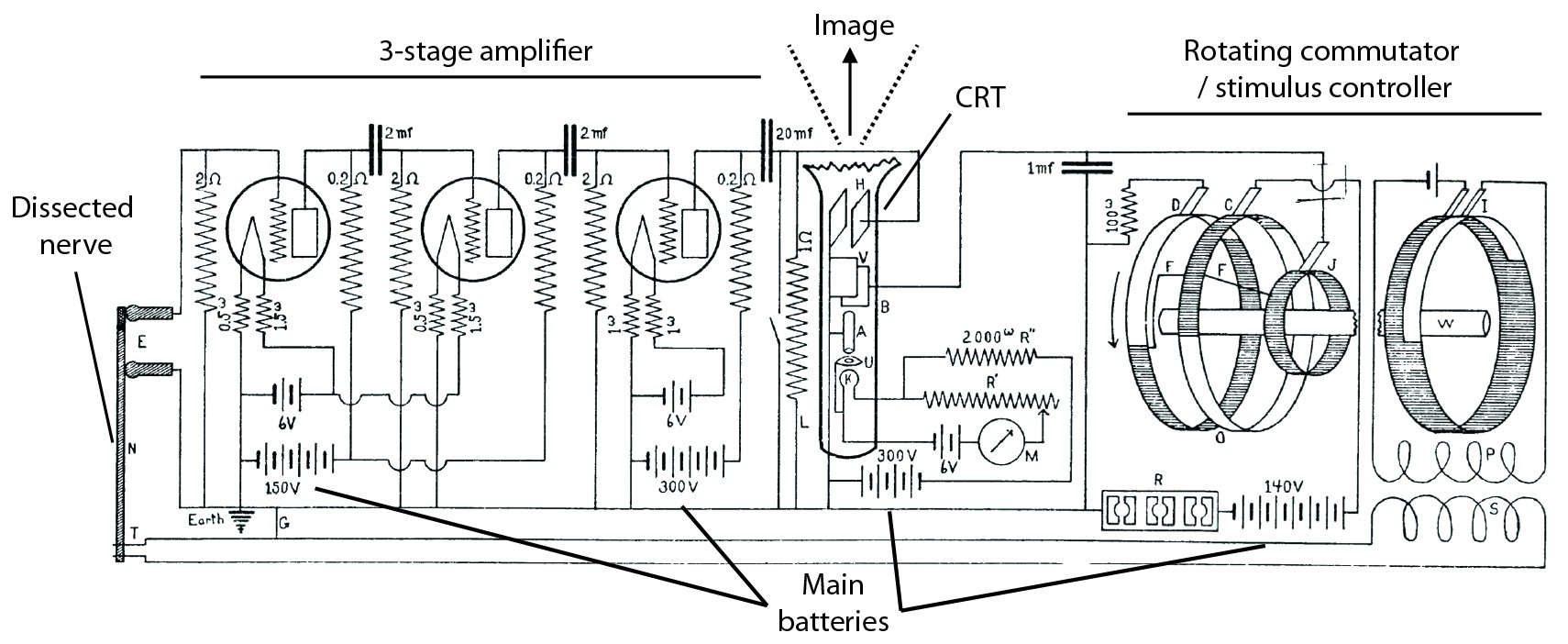Part III: Herbert Gasser, 1944 Prize in Physiology or Medicine
By Joseph Luna
 It started with a twitch. Sometime around 1770 in Bologna, Luigi Galvani charged his Leiden jar, an early capacitor, with static electricity using a hand cranked friction machine. He then took a wire connected to the jar and touched it to the exposed spinal cord of a dissected frog. We don’t fully know the original purpose of the experiment, but we remember Galvani’s name for what happened next. The dead frog’s legs moved.
It started with a twitch. Sometime around 1770 in Bologna, Luigi Galvani charged his Leiden jar, an early capacitor, with static electricity using a hand cranked friction machine. He then took a wire connected to the jar and touched it to the exposed spinal cord of a dissected frog. We don’t fully know the original purpose of the experiment, but we remember Galvani’s name for what happened next. The dead frog’s legs moved.
That first demonstration of life’s animation as the product of a then mysterious electrical force became a founding moment of neuroscience. Over the next hundred years, studies of bioelectricity would reveal that the physics of moving electrons applied to everything with a nervous system and could be measured with a device named for Luigi, the galvanometer. By the late 1800’s, nerves had been thoroughly described anatomically, and budding neurophysiologists were able to measure voltages and describe the impulses carried across scores of them. But there was a problem. While the galvanometer could measure impulses across collections of nerves, it wasn’t sensitive enough to make measurements from single nerve cells, nor was there a device fast enough to record them.
The chance overlapping of two scientific meetings in Chicago in 1920 helped change that. Attending the American Physiological Society meeting was Herbert Gasser, recently appointed to the faculty at Washington University in St. Louis by his mentor Joseph Erlanger. Gasser and an old medical school classmate, Sidney Newcomer had recently built an amplifier to boost the signal from galvanometer measurements of the canine phrenic nerve, though they couldn’t get fast enough recordings and much remained to improve. Gasser learned from a colleague that the Physical Society’s meeting across town featured a speaker from the Western Electric Company, describing a new heated cathode ray tube (CRT). Aware of its potential, Gasser slipped out of the APA meeting and heard the company’s presentation to physicists. He left convinced that he had found the right tool.
Western Electric tubes were then commercially unavailable, but Gasser and Erlanger were undeterred, and started building one using an Erlenmeyer flask coated in fluorescent paint. Coupling their homemade CRT to their amplifier, and designing the control circuit to govern the sweep of the electron beam to form an image on the bottom of the flask, Gasser and Erlanger succeeded in creating the first practical cathode ray oscilloscope for electrophysiological measurements (Fig. 1).
The device they created, with over 57 switches and needing a stack of dry cell batteries to operate, filled a room and took hours to set up properly each day, but it worked. In 1922, this time with a proper Western Electric tube, Gasser, Erlanger and George Bishop faithfully recorded the impulses of single cells in the frog sciatic nerve. This particular bit of frog wire was what Galvani had triggered to make frog’s legs jerk, and had become a favorite of neurophysiologists for its large size and stability at room temperature. It was composed, however, not of a single nerve cell but a collection of nerve cells of various diameters. Gasser, Erlanger, and Bishop showed for the first time that size mattered: far from every nerve propagating its impulse at the same speed, larger cells had faster conduction velocities than smaller cells. This unexpected observation helped explain the complex waveforms of measurements across many nerves at once, and Gasser correctly deduced that these complex waveforms could be mathematically recreated if one knew the number and size of the nerve cells contributing to it. In a sense, many of the basic conclusions reached by Gasser on the nature of the nerve impulse had been predicted or partially confirmed previously, particularly by colleagues in Britain, Charles Scott Sherrington and Edgar Douglas Adrian foremost. Still, the instantaneousness and sensitivity of the cathode ray oscilloscope was indeed a breakthrough, and before long it became a right of passage for electrophysiologists to construct their own oscilloscopes before starting experiments.
In 1935, Gasser undertook a new challenge, succeeding Simon Flexner as the second director of the Rockefeller Institute for Medical Research. This would mark the beginning of a long legacy of neurophysiology at Rockefeller, one that continues to this day (and one to which we will return frequently in this series). And it was an auspicious start: in 1944, no doubt interrupting a meeting in the succession of daily meetings and not experiments that constitute the core responsibilities of an institute head, Gasser learned that he and Erlanger had won the Nobel prize in physiology or medicine. For an MD turned engineer turned neurophysiologist turned institutional leader, it was a culmination that took Gasser by surprise. He was and is the only Rockefeller president to win while in office.
